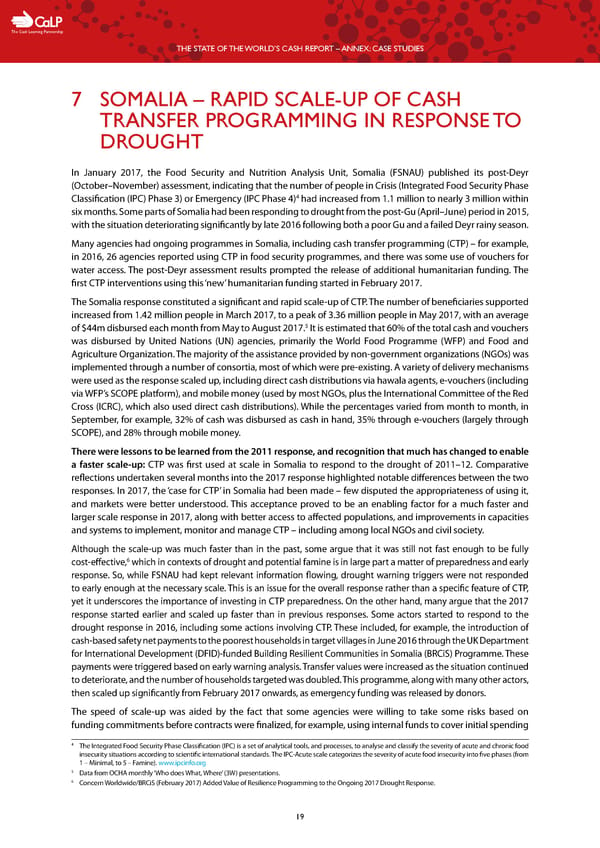C The Cash Learning Partnership THE STATE OF THE WORLD’S CASH REPORT – ANNEX: CASE STUDIES 7 SOMALIA – RAPID SCALE-UP OF CASH TRANSFER PROGRAMMING IN RESPONSE TO DROUGHT In January 2017, the Food Security and Nutrition Analysis Unit, Somalia (FSNAU) published its post-Deyr (October–November) assessment, indicating that the number of people in Crisis (Integrated Food Security Phase 4 Classification (IPC) Phase 3) or Emergency (IPC Phase 4) had increased from 1.1 million to nearly 3 million within six months. Some parts of Somalia had been responding to drought from the post-Gu (April–June) period in 2015, with the situation deteriorating significantly by late 2016 following both a poor Gu and a failed Deyr rainy season. Many agencies had ongoing programmes in Somalia, including cash transfer programming (CTP) – for example, in 2016, 26 agencies reported using CTP in food security programmes, and there was some use of vouchers for water access. The post-Deyr assessment results prompted the release of additional humanitarian funding. The first CTP interventions using this ‘new’ humanitarian funding started in February 2017. The Somalia response constituted a significant and rapid scale-up of CTP. The number of beneficiaries supported increased from 1.42 million people in March 2017, to a peak of 3.36 million people in May 2017, with an average 5 of $44m disbursed each month from May to August 2017. It is estimated that 60% of the total cash and vouchers was disbursed by United Nations (UN) agencies, primarily the World Food Programme (WFP) and Food and Agriculture Organization. The majority of the assistance provided by non-government organizations (NGOs) was implemented through a number of consortia, most of which were pre-existing. A variety of delivery mechanisms were used as the response scaled up, including direct cash distributions via hawala agents, e-vouchers (including via WFP’s SCOPE platform), and mobile money (used by most NGOs, plus the International Committee of the Red Cross (ICRC), which also used direct cash distributions). While the percentages varied from month to month, in September, for example, 32% of cash was disbursed as cash in hand, 35% through e-vouchers (largely through SCOPE), and 28% through mobile money. There were lessons to be learned from the 2011 response, and recognition that much has changed to enable a faster scale-up: CTP was first used at scale in Somalia to respond to the drought of 2011–12. Comparative reflections undertaken several months into the 2017 response highlighted notable differences between the two responses. In 2017, the ‘case for CTP’ in Somalia had been made – few disputed the appropriateness of using it, and markets were better understood. This acceptance proved to be an enabling factor for a much faster and larger scale response in 2017, along with better access to affected populations, and improvements in capacities and systems to implement, monitor and manage CTP – including among local NGOs and civil society. Although the scale-up was much faster than in the past, some argue that it was still not fast enough to be fully 6 cost-effective, which in contexts of drought and potential famine is in large part a matter of preparedness and early response. So, while FSNAU had kept relevant information flowing, drought warning triggers were not responded to early enough at the necessary scale. This is an issue for the overall response rather than a specific feature of CTP, yet it underscores the importance of investing in CTP preparedness. On the other hand, many argue that the 2017 response started earlier and scaled up faster than in previous responses. Some actors started to respond to the drought response in 2016, including some actions involving CTP. These included, for example, the introduction of cash-based safety net payments to the poorest households in target villages in June 2016 through the UK Department for International Development (DFID)-funded Building Resilient Communities in Somalia (BRCiS) Programme. These payments were triggered based on early warning analysis. Transfer values were increased as the situation continued to deteriorate, and the number of households targeted was doubled. This programme, along with many other actors, then scaled up significantly from February 2017 onwards, as emergency funding was released by donors. The speed of scale-up was aided by the fact that some agencies were willing to take some risks based on funding commitments before contracts were finalized, for example, using internal funds to cover initial spending 4 The Integrated Food Security Phase Classification (IPC) is a set of analytical tools, and processes, to analyse and classify the severity of acute and chronic food insecurity situations according to scientific international standards. The IPC-Acute scale categorizes the severity of acute food insecurity into five phases (from 1 – Minimal, to 5 – Famine). www.ipcinfo.org 5 Data from OCHA monthly ‘Who does What, Where’ (3W) presentations. 6 Concern Worldwide/BRCiS (February 2017) Added Value of Resilience Programming to the Ongoing 2017 Drought Response. 19
 The State of the World's Cash | Case Studies Page 20 Page 22
The State of the World's Cash | Case Studies Page 20 Page 22